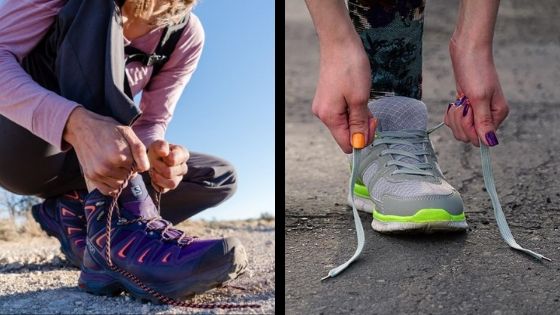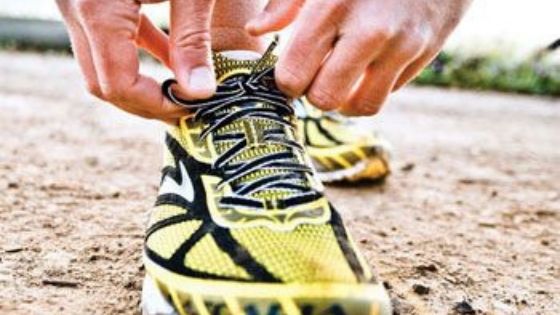
Years before I started trail running I was an avid hiker. I joined my local Mountain Club, gained mountain skills and later volunteered as a member of the Mountain Rescue Team.
I even inherited a pair of good, solid hiking boots from my good friend Arnold as a way to encourage my passion. The kind of old-school hiking boots that had a steel plate in the sole to keep them nice and rigid. That was before trail running became the next best thing.
When I first heard about trail running, I immediately jumped on board. Why not? I liked trails and I liked running, therefore putting the two together seemed like a great idea.
So I laced up Arnold’s pair of old-faithful boots and lined up on the start line. All hyped up, ready to start my next big adventure. Let’s just say, it ended less than solid for me. In short, I suffered in more ways than one. I had to seriously reconsider my footwear choices. Sticking to Arnold’s old-faithful boots or acquiring a slightly less solid and much more energetic pair of trail running shoes?
Can you trail run in hiking shoes or boots? While trail running in hiking boots is possible, the restriction in ankle and foot movement will be a painful hindrance to your ability to run. It is best to trail run in lightweight shoes that have good all-terrain traction.
So, we have established that hiking boots are generally a bad idea for trail running. However, because so much trail running shoe technology is used in hiking shoe design running in hiking shoes can be an option in certain circumstances. Let’s take a closer look at what they are.
Is Your Footwear Fit For Purpose?
There is a vast difference between hiking a trail vs running a trail. It’s all to do with the speed with which you move across the different terrains.
Trail running shoes are specifically designed for running trails. This means trail runners must be lightweight to allow for maximum performance. Typically, a trail running shoe has flexibility and ease of motion in the front of the shoe. Trail running shoes are made from much lighter materials and generally have lighter soles too.
Although tough, the soles tend to be somewhat softer without compromising ‘grip.’ This helps them give a steadier run over rocks and slick roots. Although the soles are softer, trail running shoes will typically have a rock plate in them. The rock plate will shield feet from bruising that can occur due to impact on rocks and roots.
By contrast, hiking boots are all about maximizing stability. This is done by severely restricting the lateral movement of both the foot and ankle. You need that stability when carrying a heavy pack. My mountaineering backpack used to be almost 50% of my body weight when you included my tent, climbing ropes, climbing hardware, stove, fuel and two to three weeks of food. If I needed to carry in water as well the weight of my pack would balloon.

Running in Trail Running Shoes
Trail running shoes are designed for rapid forward movement. Some models are branded as motion control and claim to promote stability in the foot – to discourage over flattening or heightening of your foot’s arch. Though it must be said that the motion control is along the front to rear axis of the shoe. Trail running shoes rely on the strength of your ankles to stabilize lateral movement.
Running shoes tend to be light-weight. The idea is that you will reduce fatigue because you can use minimal effort lifting your foot during your stride.
I remember my first pair of Brooks Cascadias. They felt so heavy on my feet, especially against the super light triathlon racing flats I was using on the road. I lost count of the number of rocks I tripped over with those shoes because I was not used to the extra force needed to lift my feet higher. At the end of a three-hour run, my form on the flat would involve my arms swinging like windmills as I tried to keep myself upright.
When you run, your body withstands a shock equivalent to 2.5 times your body weight. Running shoes with cushioning in both the heel and the forefoot help you handle this. Running shoes are flexible and designed to move with your foot.

Running in Hiking Shoes
Hiking Shoes can work but they will require more coordination when running due to their weight and higher ankle design. Hiking shoes are a good choice for day hikes or short overnight treks. It is a heavier shoe that is lighter than a full-cut or mid-cut hiking boot, but it is still sturdier than a trail running shoe. The soles are more durable and tend to have less flex in the toe box than a trail running shoe.
Insulated, waterproof and water-resistant hiking shoe options are available for hiking in wet and cold weather. Although hiking shoes offer more support of the ankle than a trail running shoe, they can inhibit the natural flex of your ankle and slow you down.
By contrast, a trail running shoe will have flexibility and ease of motion in the front of the shoe. The heavier hiking shoes would slow you and cause undue stress on the foot and joints. Most trail shoes are not water-resistant, and the uppers are made from mesh or other lightweight materials.
There is one feature on hiking shoes that can be very useful under certain very specific conditions. I am referring to the notch at the heel and the hook that is beyond the front of the laces that are designed to keep your gaiters in place. Gaiters, combined with stability and traction in soft sand makes hiking shoes the logical choice for runners at the Marathon Des Sables.

Running in Hiking Boots
Take it from someone who has tried, running in hiking boots is not the best idea in the world. Running requires way less effort in footwear that is less rigid and lighter.
Hiking boots feature a high ankle collar and are more torsionally rigid. The more flexible hiking boots tend to still be more rigid than most hiking shoes. On the opposite end of the hiking boot spectrum, you have the fully rigid boots with steel or carbon fiber plates in their midsoles. These are to accommodate crampons for trekking across glaciers and climbing slopes of snow and ice.
The tread is typically made from a harder, more durable rubber than that used on trail running shoes, and the boots’ upper portion features a range of materials, from all leather to a variety of leather-fabric-mesh combinations. Everything about the design is to support you and a backpack of up to 50% of your body weight across technical mountain terrain devoid of trails.
I remember when I was shopping for my first pair of hiking boots I was advised to get a pair with sturdy leather uppers and a thick, padded ankle collar that, too, had an outer layer of sturdy leather. This was apparently to protect against cobra bites as cobras strike in a downward arc. Yes, cobras were very common in the mountains where I grew up. Although I did see cobras over the years, I never had reason to test the theory as cobras were more afraid of me than I of them.
It is advisable to wearing trail running shoes instead of heavier, stiffer, less flexible hiking boots when running trails.
Hiking Boots vs Trail Running Shoes – Comparative Analysis
There has been a growing trend in recent years of hikers choosing lightweight trail running shoes over their sturdy walking boots. This trend has been thanks to the continuous development of trail running shoes. Where they were once the specialist domain of dedicated trail runners, they now have become the go-to choice for a wide range of outdoor pursuits.
I have broken my comparison down into the five key areas of protection, durability, comfort, climate, weight, water and breaking in. That way you can see the relative strengths and weaknesses of each style and understand what will be right for you.
Protection
Hiking Boots
One of the biggest risks when hiking with a heavy pack that can weigh as much as 50% of your body weight is misstepping and rolling an ankle. When you are in the high mountains, days or weeks away from rescue, something as simple as a rolled ankle can be fatal.
As a result, hiking boots are manufactured from thick material and generally have a tough sole providing protection for your whole foot. More importantly, what sets hiking boots apart from trail running shoes, is the high ankles that help provide lateral support and prevent you from spraining or rolling your ankles.
However, the thick soles mean you are not only higher from the ground, but also may have more shoe material under tour feet than you are accustomed to and as a result, you may be more likely to trip over something or lose your footing.
Trail Running Shoes
Trail running shoes have uppers that are made from much lighter materials and generally have lighter soles too. They won’t stand up to the same mountaineering rigors as hiking boots. Therefore protection from debris and damage won’t be of the same high level.
Trail running shoes also don’t feature high ankle cuffs either so the protection against sprains offered by hiking boots will be lacking. However, the sole is generally narrower so you are closer to the ground and, as a result, you have a decreased risk of tripping.
Durability
Hiking Boots
Hiking boots, when treated correctly, should last you for up to 1,000 miles of hiking. They are usually made with more sturdy materials and some styles will have a waterproof exterior layer that should prove effective for some time until it needs to be resealed for further usage.
Many of the top-end hiking boot models that I have used over the years do not have an outer sole that is integrated into the upper. As a result, I was able to get my boots resoled after around a thousand miles of usage and they would be good for another thousand. I had one pair of boots that I was able to have resoled four times before the uppers eventually broke down.
Trail Running Shoes
Due to their design and lighter weight, you will not get anywhere near the same amount of wear from your trail running shoes as your hiking boots. On average, you should replace your trail runners every 500 miles to prevent excessive and uneven wear that could damage your feet.
Comfort
Hiking Boots
As previously said, hiking boots are made from thicker materials that don’t offer a whole lot of wiggle room.
If you plan to do shorter hikes with a relatively light pack you will need a snug fit for effective use. This is because they won’t yield much space and due to the ankle support, you won’t have a wide range of movement.
If you are going to use the hiking boots for longer hikes where your pack will be really heavy you will need to choose a pair at least a half size larger. What I used to do is make sure that I could fit two fingers into the boot, behind my heel, after it was laced up. The reason for doing this is that the additional weight from your heavy pack will push the arches of your feet flatter and you need the space for your feet to expand.
While this helps for protection against external elements, it can also feel restrictive, so it really depends on your taste and personal preferences.
Trail Running Shoes
Trail running shoes are more compact in their construction, so they won’t feel as restrictive on your feet. The material will also offer much more flexibility and a certain degree of stretch, so you’ll have a better range of movement and flexibility.
One downside to the trail runners is the narrower sole, which means you’ll feel the bumps and rocks underfoot leading to potential pain after a long day on the move.
I remember one particular day testing a pair of racing flats that has a particularly spongy “forgiving” sole. My route included a three-mile stretch of 1400-year-old Roman cobblestones that had eroded badly into uneven jagged edges. My feet hurt for close to a week after that run.
Climate
Hiking Boots
Speaking from experience, hiking boots are better suited to the late autumn, winter, and early spring months when the weather is colder. That is at least the case everywhere I have lived. The thick material and bigger build mean that moisture vapor can’t escape properly so your feet will sweat easily.
Sweating can, in turn, causes blisters. This is mitigated by wearing double layer socks, a thin moisture-wicking inner layer, and a thick soft wool outer layer. That makes the boots even hotter to wear.
So wearing heavy hiking boots in summer can prove both uncomfortable and painful. I got into hiking while in high school and long multi-day hikes were limited to the long summer vacation so I learned all about hot feet in hiking boots.
Trail Running Shoes
Trail running shoes have multiple mesh patches as well as low cut ankles to ensure you get maximum ventilation in warm conditions. These lighter materials also mean they will dry faster, so should you do work up a sweat, all that moisture will be wicked away. Conversely, if you plan to hike in winter, trail running shoes won’t offer anywhere near the warmth you need to get through a long day of sub-freezing temperatures.
Weight
Hiking Boots
Because of the design features that give you all that extra support, hiking boots are heavier than trail running shoes by nature. Some may argue that modern hiking boots are made from lightweight synthetic materials and take some motion control technology from trail running shoes, helping them be even lighter.
That said, I have yet to see a pair of hiking boots that comes anywhere close to how light my trail running shoes are. It’s said that you consume up to six times more energy lifting weight on your feet compared to that same weight on your back. So it does make a difference on long days of a long trek when your pack is light enough.
Trail Running Shoes
These shoes have been designed for runners who are used to very lightweight running trainers. Because they weigh so little they are ideal for those who like to keep light on their feet and go for an overall lightweight kit. I have yet to see a pair of hiking boots that come close to the 10oz of my Speedgoats. (You can read more regarding what I have to say about my Speedgoats by clicking this link to the article here on Trailrunplanet)
While this is the perfect fit for many, some people enjoy the feeling of security afforded by a weightier boot underfoot.
Water
Hiking Boots
Part of hiking boot design for use in the higher mountains is to keep water from leaking in. During winter hikes through frozen conditions mean that wet boots become ice blocks laced to your feet. This severely elevates your risk of getting frostbite.
Trail Running Shoes
In general trail running shoes won’t offer you anywhere near the same level of waterproof protection as hiking boots. However, this is in no way a hindrance.
If your trail running shoes get completely submerged in a river crossing and fill to the brim with water, they will dry out much quicker than hiking boots. As a result, many hikers prefer trail running shoes for long hikes when river crossings are likely. This also makes trail running shoes the better option for running in wet conditions that are not very cold.
Breaking in
Hiking Boots
Your hiking boots need to be broken in before you take them out for any serious hiking. Start them off with short walks at home. Gradually progress to a longer walks outside before working up to a full-length hike. Failing to do this will just set you up for a painful day on the trails.
Modern synthetic boots require less breaking in than old-school leather boots. Back in the day, we used to fill our brand new leather boots to the brim with hot water. Then, once the leather was soft, we’d put our socked feet into the water-filled boots and keep them on till they eventually dried out. We’d usually have massive blisters but boots that had been molded to the shape of our feet in one sitting.
Trail Running Shoes
I have yet to buy a pair of trail running shoes that require any breaking. Every pair so far has been good to go straight out of the box.
Even on super long hikes like the Camino de Santiago in Spain, almost all the pilgrims wear trail running shoes for their long walk. On the longer, 30-day plus versions it is common to completely wear out two pairs of trail running shoes depending on the heat. Hot rubber wears out faster than cold rubber. The good news is you can change pairs on the fly in one of the larger towns along the way when your shoes wear out.
